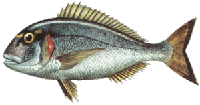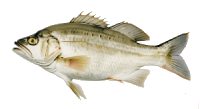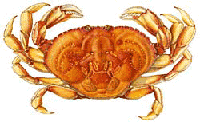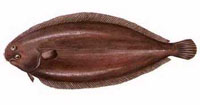
 Eel sushi. The eel is purchased pre-cooked, then grilled at the restaurant with “eel sauce.” Photo © SDS Studio | Fotolia.com
|
|
|
This glossary was compiled by THE NIBBLE EDITORS. It is updated regularly.
|
|
October 2005
Last Updated July 2010
|
 |
Fish & Seafood Glossary
Page 4: Seafood Types Beginning With D & E
This is Page 4 of a 13-page glossary featuring different types of fish and seafood. Here, seafood types beginning with D and E, such as daurade, dogfish, dungeness crab and eel. Click on the links below to visit other pages. See our many other food glossaries, each featuring a different favorite food.
Click on a letter to go to the appropriate glossary page.
a b c d e f g h i j k l m n o p q r s t u v w x y z
This glossary is protected by copyright and cannot be reproduced in whole or part.
DAURADE
The French name for any of several freshwater or saltwater fish, including the American porgy and the Japanese sea bream. While the name “daurade” sounds sophisticated, the fish does not lend itself to sophisticated preparations. It is generally baked, grilled, sautéed or fried. Not to be confused with dorado, another name for mahi-mahi.
|
|
 |
| Photo courtesy of PecheWeb.com. |
DOGFISH
|
Not a fish, but rather a general name for several species of smaller sharks, some of which run in schools. The most famous of these sharks are the spiny dogfish and the smooth dogfish. The dogfish name refers to the size and shape of the fish, and the young are even called “pups.” Dogfish can found in the Pacific and Atlantic Oceans as well as the Mediterranean Sea.
|
|
 |
| Lesser Spotted Dogfish. Illustration copyright Galindorf.com. |
Dogfish has a firm, moderately lean flesh with a fairly strong flavor. It is used in many cuisines but is generally considered trash fish in the U.S., and is difficult to find in markets here, although becoming more available. In the U.K. it is widely used for Fish and Chips.
DORADO
Another name for mahi-mahi. Not to be confused with the daurade.
DOVER SOLE
See English sole.
DRUM
|
A name for a large family of fish, as well as of several members of that family. A large subclass of drums is the croaker. The name arises from a strange drumming or deep croaking noise they make, chiefly during breeding season. Carnivorous, spiny-finned fish, the drum are found in both the Atlantic and Pacific, with one, the freshwater drum, found in mid-North American freshwater. The drum have a firm, low fat flesh. Croakers, the smallest of the drum family, average only a pound and are usually sold whole.
|
|
 |
| Atlantic croaker. Illustration courtesy of Gemini. |
Other drum weigh up to 30 pounds and can generally be found in fillets and steaks. Some of the drum family include the Atlantic croaker, common or black drum, hardhead, kingfish, red drum, redfish, spot, spot-fin croaker, weakfish, white seabass and whiting.
DUNGENESS CRAB
|
Typically associated with the Pacific Northwest, this crab was first commercially harvested in the town of Dungeness, Washington. Dungeness crab can be found from Alaska to Mexico. A large crab, it can range from one to four pounds, and yields excellent meat that is sweet, yet slightly marine in flavor—one of the most flavorful of all crabs. Typically, it is steamed, and eaten with fingers by removing the top, breaking it in half, and removing the viscera and the “dead man’s fingers,” or gills, then serving with drawn butter and a nutcracker or mallet. It can be served chilled or hot. See also Crab.
|
|

Photo courtesy of TridentSeafoods.com. |
EEL
|
Not a popular fish in the U.S. except as unagi sushi, eel is enjoyed in Europe and Japan, where it is treated as a delicacy. This long, snakelike fish can be found in both fresh water and salt water. All species have a smooth skin with minute scales. The most interesting culinarily are the common eel and conger eel. The common eel is small and sold live
|
|
 |
| American Eel. Photo courtesy of VSV.Cape.com. |
The larger conger eel can reach 10 feet and more than 170 pounds, and is sold as steaks. Both varieties have an oily, sweet, firm meat. Before cooking, the thick, tough skin, once used as leather, must be removed. The common eel can be baked, stewed or grilled; but the tougher meat of the conger eel requires a braise, soup or stew. Eel can also be found jellied (especially popular in England) or smoked. Eel trivia: In parts of the Philippines, according to legend, eels are the souls of the dead. In Europe, rubbing the skin with eel oil will cause a person to see fairies.
ENGLISH SOLE or DOVER SOLE
|
In the U.S., English sole is rarely found. Rather, the “filet of sole” found here is a species of flounder, also commonly called lemon sole. In Europe, this flatfish is a true sole that has a fine textured, low fat flesh. True English sole is a small fish, ranging from 1/4 to 2 pounds, and when it can be found, it is usually already filleted and labeled “Fillet of Sole.” (Americans use the French word filet rather than the English word fillet.) English sole is usually prepared in ways to protect its fine texture, such as baking, broiling, poaching and sautéing.
|
|
 |
| Photo courtesy cefas.co.uk. |
Continue To Page 5: Seafood Terms Beginning With F
Go To The Alphabet Index Above
Lifestyle Direct, Inc. All rights reserved. Images are the copyright of their respective owners.

|